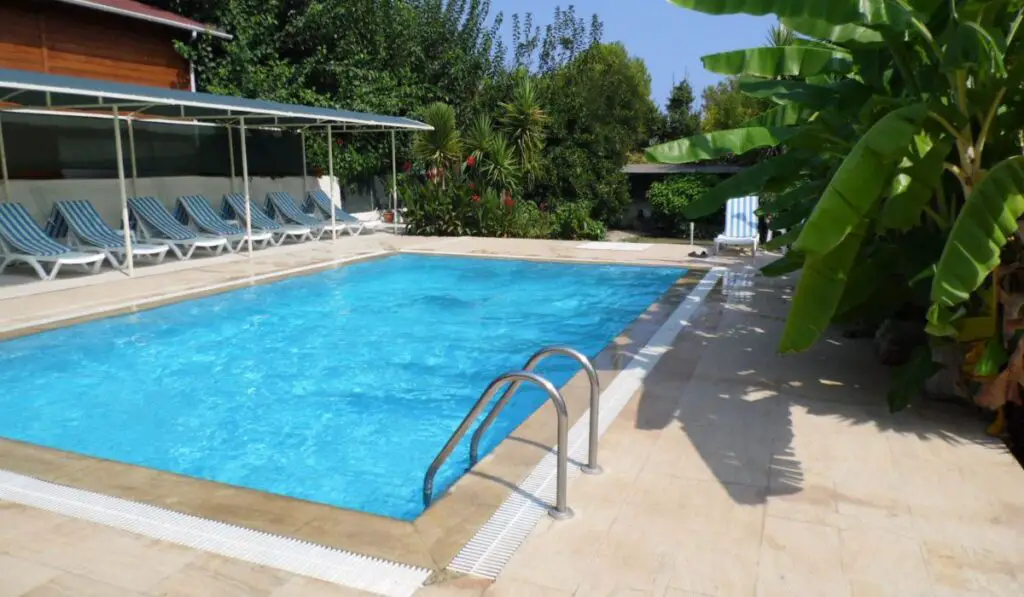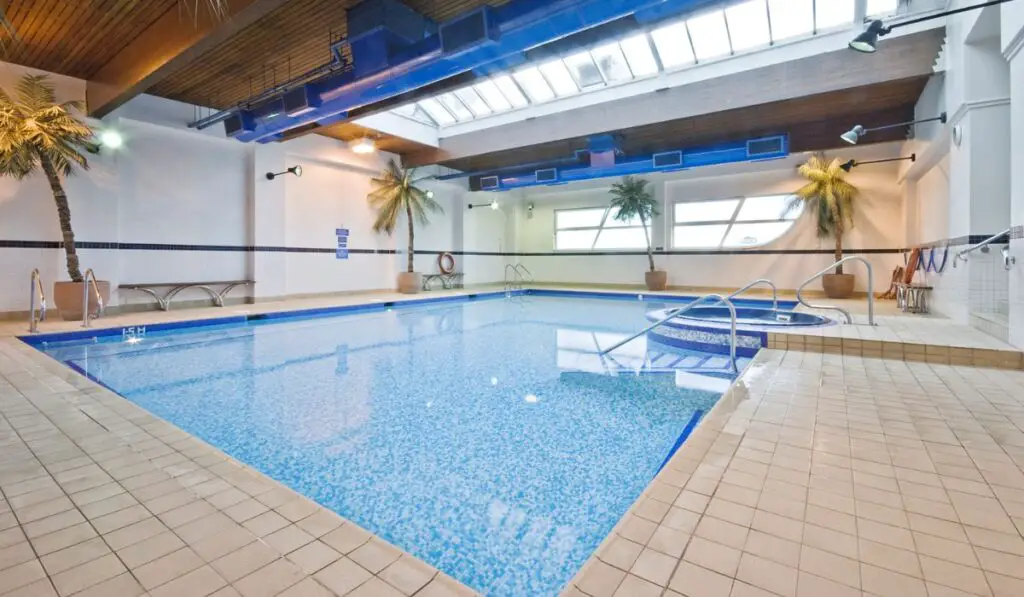There’s nothing worse than planning to dive in clear, bright, and sparkling water, only to find that your pool has suddenly turned cloudy, milky, or hazy. If your pool water isn’t as clean as it should be, then either chemical imbalances, environmental factors, or pool filtration is usually to blame. And the first step to fixing all three of these issues is to get a testing kit.
You can fix cloudy or white pool water by monitoring your pool’s total alkalinity and pH and cleaning the pump and filter. Try to keep the pH between 7.2 and 7.8 and the alkalinity between 80 and 120 ppm. If that doesn’t work, the pool may be over-stabilized and need partial draining and refilling.
Luckily, most fixes for cloudy or white pool water are extremely easy, but it might take a bit of trial and error to determine exactly what your pool’s problem is. Let’s look at why your pool water may be white and what you can do to fix it, so you can host your next pool party without worrying about any health hazards.
Why Your Pool Water Is White

White or cloudy pool water can be an indication of imbalanced pool chemicals. If left unaddressed, this imbalance can cause irritated skin, red eyes, and rashes.
Pool water also becomes cloudy when a large number of tiny particles of matter either fall or are introduced into the water. These particles reflect light, which makes your swimming pool appear cloudy and white.
In rarer cases, the fogginess is from over-stabilization caused by using too many chlorine pucks or a chlorine treatment that includes stabilizer. If too much stabilizer builds up, you have to partially drain and refill the pool to dilute it.
There are countless other reasons behind white pool water, and all of them fall into one of three categories: equipment-based, environmental, and chemical.
Equipment-based Factors
Most of the time, pool water turns cloudy simply because it’s not receiving sufficient filtration. Here are a few equipment factors that can contribute to white pool water:
Inadequate or Inappropriate Filter Equipment
If your pump or filter is too small for the volume of your pool, then you’ll have cloudy pool water. Similarly, if the motor of your pump has too high a horsepower, the water will be pushed too fast through the filtration system, and you’ll actually end up with reduced filtration.
Damaged or Dirty Filter
A dirty filter or a clogged filter basket could be the reason behind cloudy pool water. Make sure you backwash both the pump basket and filter until the water runs clear. If your pool is equipped with a cartridge filter, remember to check it regularly and replace or clean it if necessary.
Inadequate Circulation
This could be because the valves are open when they should be closed, or closed when they should be open. Water flow could also be obstructed if the skimmer basket is clogged with plastic, leaves, or other debris.
Environmental Factors
These factors include almost all the contaminants surrounding the pool that could hinder the filtration process, such as:
Debris
Pollen, leaves, and dust are usually too fine for your filtration system to pick up and actually end up impeding the cleaning process. Bird droppings and dead insects also contribute to white pool water.
Water Run-off
Run-off water after a rain or storm could result in cloudy pool water. This water brings in minerals, such as phosphates, sulfates, silicates, and nitrates into your pool, which make the water cloudy.
Algae
A cloudy pool might be an early indication of an algae bloom, especially if your pool water develops a greenish tint as well. The water may start out looking a bit hazy but will turn green pretty quickly.
Chemical Factors
Achieving the right water chemistry is the most difficult part of pool maintenance. Adding incorrect amounts or using the wrong chemicals entirely are the major reasons behind cloudy water and might even result in algae if proper care is not taken.
Improper Chlorine and pH Levels
While an improper pH does not directly result in cloudy water, it affects the way chlorine and other pool cleaning chemicals work in the water. Extremely high pH prevents calcium from dissolving properly, resulting in cloudy water and calcium scaling in both non-saltwater and saltwater pools.
Conversely, a very low pH makes chlorine more reactive and causes a faster depletion. A lower than recommended pH level also forms lots of chloramines, which turns the water white and makes chlorine ineffective in killing algae, bacteria, and other contaminants in the water.
High Total Alkalinity
It’s important to closely monitor the level of total alkalinity in your pool. High TA causes calcium scaling and increases pH, both of which contribute to a cloudy pool.
Other Chemical Imbalances
High levels of bromine, phosphate, and imbalance stabilizers, like cyanuric acid, can cause cloudiness. High calcium hardness can also lead to calcium scaling in the pool, resulting in poor filtration and cloudy or dirty water.
How To Fix White/Cloudy Pool Water
The good news is that most fixes for cloudy or white pool water are fairly simple. Most of the time, you just need to add the right dose of a flocculant (on Amazon) or clarifier (also on Amazon) to get rid of the cloudiness. Here are a few other things you can do to make your pool crystal clear again:
Monitor Total Alkalinity and pH
Your pool water’s pH level affects the effectiveness of all other chemicals, including chlorine. Imbalanced pH can cause cloudiness, while high total alkalinity can result in bacteria growth and other health hazards. A high pH also makes pool water look dull, so it’s best to maintain the water’s pH between 7.2 and 7.8.
Balancing Your Pool’s pH
If the pH of your pool is too high, try using a pH reducer, like sulfuric acid (on Amazon) or muriatic acid to bring it back within the recommended range. Anything below 7.0 is too low, so use a pH increaser with soda ash (also on Amazon) if the pH drops too low.
Balancing Your Pool’s Total Alkalinity
It’s best to maintain total alkalinity levels within the recommended range of 80 ppm to 120 ppm to avoid calcium scaling and high pH levels. You can easily lower total alkalinity by adding muriatic acid (on Amazon) and then aerating the pool to restore proper pH levels.
Clean the Pool Pump and Filter
If your pool pump or filter is clogged or damaged, then the water in your pool will become cloudy and stagnant. Here’s what you can do to fix poor circulation:
- Ensure that all the return jets are pointed at a downward angle, so the water at the bottom of your pool is circulated properly. Make sure you also have the right pump size to move and clean the water.
- Check whether you’re running your filtration system long enough. Ideally, you should run your filter 24/7 to ensure clean water at all times. However, if your swimming pool isn’t used that much, running the filter for at least eight to 10 hours a day may suffice.
- Remove any particles that might be clogging your filter by regularly cleaning and backwashing it. Make sure you also replace your cartridge and D.E. filter medium as necessary. Cartridge filters usually have a life of around 2,000 hours, so remember to replace them every one to two years, depending on their usage.
Perform Regular Pool Maintenance
You can easily fix a cloudy pool by keeping up with regular maintenance and adding a clarifier to the water. A pool clarifier works as a coagulant and bonds together all the loose pollen, dirt, and other small particles into bigger clumps, making it easier for your filtration system to capture and filter them out.
However, keep in mind that it can take more than 24 hours for a clarifier to clear up the cloudy pool water. And even if you get rid of pollen and dirt, there are still a few environmental factors, like resident wildlife or nearby construction, that are outside of your control.
If your pool gets contaminated frequently, it’s best to make clarifying a part of your routine pool maintenance to protect the quality of your pool water. It’s also advisable to test the water two to three times every week using a testing kit (on Amazon) to ensure a balanced chemical composition.
If the tests show an imbalance, make sure you add all the appropriate chemicals needed to return your pool to its balanced state.
By committing just a bit of time and effort to regular maintenance and testing, you’ll be able to minimize repairs and keep your pool water clear at all times.
Lastly, plan to partially drain and refill your pool a couple times a season to avoid over-stabilizing the chlorine and causing clouding.
How To Naturally Make Your Pool Clean

Treating a pool primarily consists of balancing alkalinity and acidity and maintaining a pH level between 7.2 and 7.8. However, if you don’t want to add chlorine, you can use baking soda (on Amazon) to naturally make your pool clean.
Here’s how you can use baking soda to increase the pH and alkalinity of your pool:
- Regularly test the alkalinity of your pool. If alkalinity is lower than normal, particularly if it’s less than 80 ppm, then you’ll need to increase it.
- Calculate the total amount of baking soda you’ll need to add. A good rule of thumb is that by adding 1.5 pounds of baking soda for every 10,000 gallons of water, you’ll be able to increase alkalinity by around 10 ppm.
- If the pH of your pool is below 7.2, add three to four pounds of baking soda. If you’ve never used pool chemicals before, add only three-fourths or one-half of the recommended amount first. Then, retest the water and add more if needed.
- Baking soda is available in powder form, so you can sprinkle it directly into the pool water. Spread it in wide arcs across the surface of your pool and make sure you don’t dump the entire amount in just one spot. Also, try to avoid adding it on windy days, as the powder might go airborne.
- Wait six hours for the baking soda to dissolve and disperse into the water. It’s also advisable to turn on your pool pump to ensure even distribution.
- Retest your pool’s total alkalinity and pH 24 hours after adding baking soda. If the pH still tests below 7.2 or the alkalinity remains below 80ppm, repeat all these steps.
